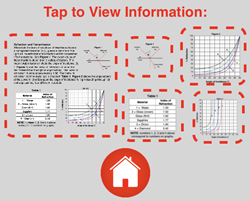About Reflection vs. Transmission
Highly Recommended

Like all our Science Reasoning Center activities, the completion of the Reflection vs. Transmission activity requires that a student use provided information about a phenomenon, experiment, or data presentation to answer questions. This information is accessible by tapping on the small thumbnails found on the bottom right of every question. However, it may be considerably easier to have a printed copy of this information or to display the information in a separate browser window. You can access this information from
this page.
The Standards
The Reflection vs. Transmission activity describes the variables that affect the percentage of incident light that undergoes reflection and transmission at the boundary between two materials. The passage uses a diagram, a table and two graphs to describe the relationships among variables. Questions target a student's ability to identify the effect of one variable on another variable, to select information from two or more data presentations, to make a prediction based on two or more data presentations, to interpolate and extrapolate from a graph, to compare data chosen from two or more graphs, and to use known data to make a prediction regarding an untested scenario.
Success with the activity requires some degree of proficiency with respect to ...
- Developing and Using Models (Science and Engineering Practice 2.3)
Develop, revise, and/or use a model based on evidence to illustrate and/or predict the relationships between systems or between components of a system.
- Developing and Using Models (Science and Engineering Practice 2.4)
Develop and/or use multiple types of models to provide mechanistic accounts and/or predict phenomena, and move flexibly between model types based on merits and limitations.
- Planning and Carrying Out Investigations (Science and Engineering Practice 3.5)
Make directional hypotheses that specify what happens to a dependent variable when an independent variable is manipulated.
- Analyzing and Interpreting Data (Science and Engineering Practice 4.1)
Analyze data using tools, technologies, and/or models (e.g., computational, mathematical) in order to make valid and reliable scientific claims or determine an optimal design solution.
- Using Mathematics and Computational Thinking (Science and Engineering Practice 5.3)
Use mathematical, computational, and/or algorithmic representations of phenomena or design solutions to describe and/or support claims and/or explanations.
- Constructing Explanations and Designing Solutions (Science and Engineering Practice 6.1)
Make a quantitative and/or qualitative claim regarding the relationship between dependent and independent variables.
- Patterns (Crosscutting Concept 1.2)
Empirical evidence is needed to identify patterns.
- Scale, Proportion, and Quantity (Crosscutting Concept 3.2)
Algebraic thinking is used to examine scientific data and predict the effect of a change in one variable on another (e.g., linear growth vs. exponential growth).
While the Reflection vs. Transmission activity addresses the five NextGen Science and Engineering Practices and the two Crosscutting Concepts above, the activity drew its greatest inspiration from
ACT's College Readiness Standards for Science Reasoning. The activity consists of 49 questions organized into 14 Question Groups that are spread across the three difficulty levels. A single strand (Interpretation of Data - IOD) of the College Readiness Standards is addressed in this activity. The code given for the standard includes three letters (IOD) to indicate the strand and three numbers to indicate the specific standard within that strand. Higher numbers are indicative of more complex science reasoning skills. The relationship between the questions and the standards is as follows:
Complementary and Similar Resources
The following resources at The Physics Classroom website complement the Reflection vs. Transmission Science Reasoning Activity. Teachers may find them useful for supporting students and/or as components of lesson plans and unit plans.
Physics Classroom Tutorial, Refraction and the Ray Model of Light Chapter: Lesson 3
Physics Video Tutorial, Refraction and Lenses: Total Internal Reflection
Physics Video Tutorial, Refraction and Lenses: The Critical Angle
Physics Interactives, Refraction and Lenses: Refraction Simulation
Concept Builders, Reflection and Refraction: Total Internal Reflection
Minds On Physics, Refraction and Lenses Module, Mission RL5: Total Internal Reflection
Minds On Physics, Refraction and Lenses Module, Mission RL6: The Critical Angle
The Calculator Pad, Refraction and Lenses, Problem Sets RL10 - RL12